2022 Science Highlights
Time Domain Studies and Fundamental Physics
NRAO facilities provide unique and powerful windows on transient and variable cosmic phenomena, as well as incisive probes of the most extreme physical processes in the Universe.
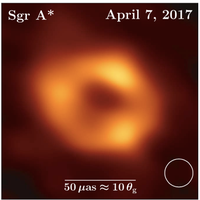
The VLBA produced an important measurement of the absolute position of SgrA* this year (Xu et al. 2022), improving the astrometric accuracy to about 0.5 mas, about an order of magnitude better than previous measurements. Also measured was a much-improved proper motion of SgrA*, found to be -3.152±0.011 and -5.586±0.006 mas/year in the easterly and northerly directions, respectively. These measurements are crucial for future studies of general relativistic effects on stellar orbits in the vicinity of SgrA*.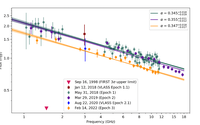
The VLASS completed its second epoch of observations in February 2022. It continues to provide unique insights into the nature of transient radio sources. One recent highlight is the discovery of a candidate extragalactic emerging pulsar wind nebula, VT 1137-0337 (Figure 2; Dong et al. 2022). This was identified by comparing VLASS Epoch 1 to the earlier Faint Images of the Radio Sky at Twenty-cm (FIRST) survey, Subsequent follow-up showed that it is a flat-spectrum radio source in a dwarf starburst galaxy that is now slowly fading, making it an excellent candidate for a newly emerged pulsar wind nebula.
A recent highlight from non-transient applications of VLASS is the combined use of VLASS and the southern Rapid ASKAP (Australian Square Kilometer Array Pathfinder) Continuum Survey (RACS) to measure the dipole produced by the motion of the Milky Way relative to the cosmic background. In contrast to some previous studies, this joint VLASS/RACS study showed results consistent with those obtained by measuring the dipole in the Cosmic Microwave Background (CMB) with the Planck satellite (Darling, 2022, ApJL, 931, 14).
Betelgeuse (𝛂 Orionis) is the closest red supergiant, on the verge of a supernovae explosion. The star is variable on yearly timescales. In early 2020, the star faded to an historically low brightness. This dimming may be due to dust formation in a major mass loss event driven by photospheric convection, or unusual photospheric cooling. VLA 7mm and 1.3cm observations just prior to the dimming find a gas temperature of 2270 K at twice the optical photospheric radius, about 500 K cooler than previous measurements (Matthews & Dupree 2022, ApJ, 934, 131). No giant convective cells were seen, but the observed radio photosphere is inconsistent with a uniform disk, but has large-scale, ring-like structure. The results are consistent with the passage of a major shock wave through the outer atmosphere, possibly driven by large-scale mass ejection.
Large programs at the VLA and VLBA continue to explore the new window of time domain astronomy in a broad range of physical regimes. These include programs to identify electro-magnetic counterparts to gravitational wave sources discovered by LIGO, and to determine arc-second positions of Fast Radio Bursts (FRB) and monitor repeating FRBs. The VLA participates in the Nanohertz pulsar monitoring program to discover the gravitational wave background from the Big Bang, while the Monitoring Of Jets in Active galactic nuclei with VLBA Experiments (MOJAVE) program continues to set the standard for monitoring the temporal evolution of milliarcsecond structure in powerful relativistic radio jets on decadal timescales.
Solar System and Planetary Science
The NRAO facilities worked in concert with deep space probes and other ground-based facilities to study the physics and chemistry of objects in the Solar System.
Oort-cloud comet C/2014 UN271 (Bernardinelli-Bernstein) was discovered at ~29 AU from the Sun (Lellouch et al. 2022 A&A 659, 1L), developing cometary activity early with a brightness suggesting a large size. ALMA detected thermal emission when the comet was at 20 AU distance from the Sun, from which a surface-equivalent diameter of 137 km is calculated. It is thus the largest Oort-cloud object ever found, (almost twice as large as comet C/1995 O1 Hale-Bopp) and has a normal cometary albedo. Detection of gases is expected in the upcoming years as the comet heads toward a perihelion of 11 AU in 2031.
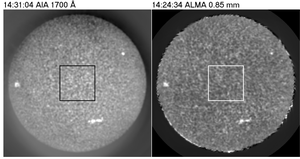
Allisandrakis et al. (2022, A & A, 661, L4) present the first full-disk Solar images (Figure 3) obtained with ALMA, using Band 7 (0.86 mm; 347 GHz). The results show a disk practically devoid of active regions at their 21" resolution. Solar structures on the disk are similar to those in Atmospheric Imaging Assembly images at 1600 Å and 304 Å; they are also similar to negative Hα images of equivalent resolution. Small plage regions are about 900K brighter than their surroundings, while the polar coronal holes and small Ha filaments are not detectable. The authors deduced a brightness temperature at the center of the disk of 6085 K at 0.85mm, rather than the 5500 K extrapolated from images at 3mm and 1.3mm, an indication that at 0.85mm we are approaching the temperature minimum.
With the ever-increasing number of known exoplanets, many in the habitable zone, understanding the effects of stellar activity (exospace weather), on the potential development of life has become paramount. ALMA, working in concert with a multi-wavelength arsenal of space and ground-based telescopes, has measured the faintest flare to date on the nearby (1.2pc distance) M dwarf star, Proxima Centauri, which hosts a planet in the habitable zone (Howard et al. 2022). The X-ray flare is well within the luminosity range of typical flares on the Sun, while the millimeter emission is two orders of magnitude stronger than typical Solar flares. The findings provide more evidence that millimeter emission is a common feature in weak exo-stellar flares, rising and falling in timescales of seconds. The implied temperature for the corona is 1.1x107 K.
Star and Planet Formation and Evolution, and the Search for Life
The NRAO facilities remain the work-horse radio observatories for study of the physics and chemistry of star and planet formation in the Milky Way and nearby galaxies.
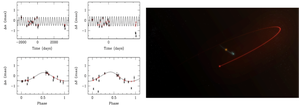
Thousands of planets are now known, but study of planetary orbits in common binary star systems remains under-explored. Precision (tens of mas) astrometry at 8 GHz with the VLBA has traced the 3D structure of the orbits of the binary star system, GJ896AB, consisting of 0.4Mo and 0.2Mo stars with an orbital period of 229 days at Neptunian separation. Both dwarf stars are magnetically active and have sub-mJy, variable radio emission. The motion of star A implies a 2MJup planet orbiting with a period of 284 days at a Venusian distance. The surprise was that the planet is in retrograde orbit relative to the binary stars. Seeing such a large planet in a retrograde orbit in a very compact binary system challenges theories of planet formation (Figure 4; Curiel et al. 2022, AJ, 164, 92).
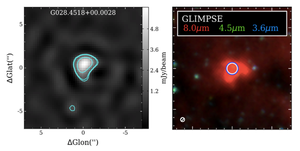
This year saw the publication of results from the Global View of Star Formation in the Milky Way (GLOSTAR; Figure 5; Dzib et al. 2022) large program at the VLA. GLOSTAR is a survey of a large region of the Galactic plane at 4–8 GHz with an unprecedented resolution and sensitivity of 1” and 60mJy. Almost 1500 radio sources are identified at high significance, including radio stars, planetary nebulae, and HII regions associated with both young stellar objects in clusters and with massive stars. The results have wide impact on areas ranging from stellar atmospheres to the birth and death of stars.
Results from the ALMA Molecules with ALMA at Planet-forming Scales (MAPS) Large Project target were published this year. An important result was the discovery of a circumplanetary disk (CPD) associated with accretion onto a forming planet in the dusty circumstellar disk around the T Tauri star AS209 (Bae et al. 2022, ApJ 934, 20). The CPD is less than 14 AU in size, and is located 200 AU from the parent star. The planet was isolated by velocity perturbations seen in the 13CO J=2-1 emission. The velocity field suggests kinematic influence of an embedded giant planet of about 0.1MJup; the data also suggest localized gas heating. The age of the system is only one to two million years, implying a very young exoplanet. ALMA also detected a dusty accretion disk around the T Tauri binary star system, SR 12 c. This system has an 11 MJup planetary-mass companion orbiting 980 AU from its host binary (Wu et al. 2022, ApJ 930, 3). In contrast to AS209, seen only in line emission, the SR 12 disk was seen only in dust emission.
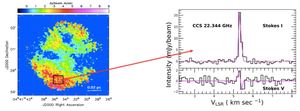
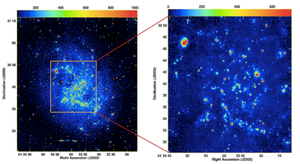
The VLA has completed a survey of the M33 galaxy (Figure 7; Tabatabaei et al. 2022) at 1.5 GHz and 6.3 GHz, with resolutions down to 30pc, sufficient to isolate individual giant molecular clouds (GMC)—the dominant sites for star formation in galaxies. The broadband, multifrequency observations allow for a separation of thermal and non-thermal emission. The results provide the most detailed, dust-unbiased measure of the star formation law relating star formation rate to molecular gas content of GMCs. The non-thermal emission provides details as to the generation of magnetic fields via a turbulent dynamo driven by star formation and supernovae.
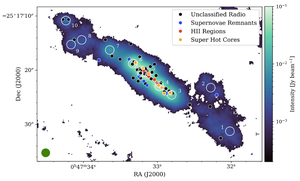
The ALMA Comprehensive High-resolution Extragalactic Molecular Inventory (ALCHEMI; Figure 8; Behrens et al 2022) Large Program at ALMA provides a multi-band, beam-matched spectral scan of the Central Molecular Zone (CMZ; 850x340pc) of the starburst galaxy NGC253 at GMC resolution (1"=17pc). Five papers this year provide a molecular inventory via reliable templates of chemistry and excitation in one of the closest nuclear starburst galaxies at GMC scales. These papers find major differences in the CMZ relative to the rest of the galaxy disk, including (i) greatly enhanced cosmic ray density, (ii) orders of magnitude lower gas-phase CO2 abundance at the galaxy center, and (iii) efficient CO2 sublimation onto ice grains. These differences likely result from the very high star formation rate along the CMZ.
Numerous large programs on star and planet formation are underway at ALMA and the VLA. These include a comprehensive study of the Orion star forming region, very high resolution imaging of sub-structure in proto-planetary disks, continued exploration of the gas and chemistry of proto-planetary disks, and determination of the bulge structure on the far side of the Galaxy.
Galaxies and Galaxy Formation
The VLA and ALMA provide the unique capability to study the cool gas and dust in galaxies. These are key constituents in fueling star formation, and act as star formation tracers. The VLBA provides the complimentary ability to study the bright radio continuum structures on tens of pc-scales, associated with the most distant Active Galactic Nuclei (AGN).
The order of magnitude decline in the cosmic star formation rate density over the last 10 Gyr is a well constrained, but not well understood, phenomenon. It has long been assumed that the cause for cessation of star formation in galaxies is depletion of the molecular gas via strong winds and shocks driven by the star formation itself. SDSS J1448+1010, at z = 0.65, is a post-merger galaxy which had a sharp drop-off in star formation some 70Myr ago. ALMA observations of CO 2-1 emission show that this system still has plenty of molecular gas, but that the gas has been torn from the main galaxy into a 64 kpc tidal stream due to the recent merger. These observations suggest an alternative mechanism for quenching star formation in galaxies via major mergers, as opposed to just starburst driven dynamics (Figure 9; Spilker et al. 2022, ApJ 936, L11).

The VLBA remains the only instrument that can probe AGN radio structure down to tens of pc-scales in the most distant galaxies. A recent exciting result came from 1.4 GHz VLBA observations of the low luminosity radio AGN in the z ~ 6 quasar, J2242+0334. These observations imply a highly resolved radio source at 10 mas resolution (60 pc), implying a wind-like radio emitting region, and not a typical high brightness relativistic core-jet. These observations provide clues as to the nature of the radio emission from the lower luminosity radio AGN in the early Universe.
ALMA, working in concert with the JWST, has identified a dust and molecule rich grand design spiral galaxy at z = 3.06. The galaxy has a radius of 7 kpc, and a star formation rate of 85 M⊙/yr, with the dust and star formation revealed by ALMA concentrated in the galaxy center. The CO lines provided the spectroscopic redshift for this galaxy. Existence of an apparently mature, metal enriched, large spiral galaxy just 2 Gyr after the Big Bang challenges mechanisms for galaxy formation in the early Universe (Figure 10; Wu et al. 2022).

The ALMA Large Programs: Reionization Era Bright Emission Line Survey (REBELS), ALMA Large Program to Investigate C+ at Early Times (ALPINE), and ALMA Lensing Cluster Survey (ALCS), have targeted identifying and performing a first characterization of many of the most luminous star-forming galaxies known in the z > 6.5 universe. REBELS systematically scans 40 bright UV-selected galaxies in a 7 degree square area for bright [C II]158 μm and [O III]88 μm lines and dust-continuum emission. Initial results (Bouwens et al. 2022, ApJ 931, 160) identified 18 objects with [C II] emission (see Figure), 13 of which also show dust continuum emission. An analysis of these search results vs. Star Formation Rate (SFR) suggests an ~79% efficiency in scanning for [CII] when the SFR(UV+IR) is in excess of 28 Mo/yr.
The first ultra-deep fields with the JWST have identified an unexpectedly large number of extreme redshift galaxy candidates at z > 10, or within 500 Myr of the Big Bang. However, these first galaxy candidates are based on photometric redshifts only—spectroscopic verification of the redshifts remains critical. ALMA provides the unique potential to obtain spectroscopic redshifts using fine structure lines. ALMA has observed the z ~ 12.0 JWST candidate, GLASS-z13, at 250 GHz, searching for both the [OIII] 83um line and thermal continuum emission. Non-detection of the dust continuum implies a dust-poor galaxy, consistent with the blue optical color. A marginal (4𝝈) detection is made of the [OIII] line at z = 12.1, offset by 0.5” from the optical galaxy. While the probability of this line being noise remains significant (Kaasinen et al. 2022), the general point remains that ALMA can be an important tool in the spectroscopic verification, and characterization, of the first galaxies candidates from JWST (Figure 11; Bakx et al. 2023).
![Figure-01-01-04-03.png Figure 11. Tentative [OIII] 88um emission seen by ALMA at 256 GHz, from the z = 12.1 JWST galaxy candidate GLASS-z13 (Bakx et al. 2022, arXiv:2208.13642).](https://science.nrao.edu/science/highlights/images/2022/Figure-01-01-04-03.png/@@images/bbab6da0-bfab-4545-a39d-d22be1d6a6ff.png)




Connect with NRAO